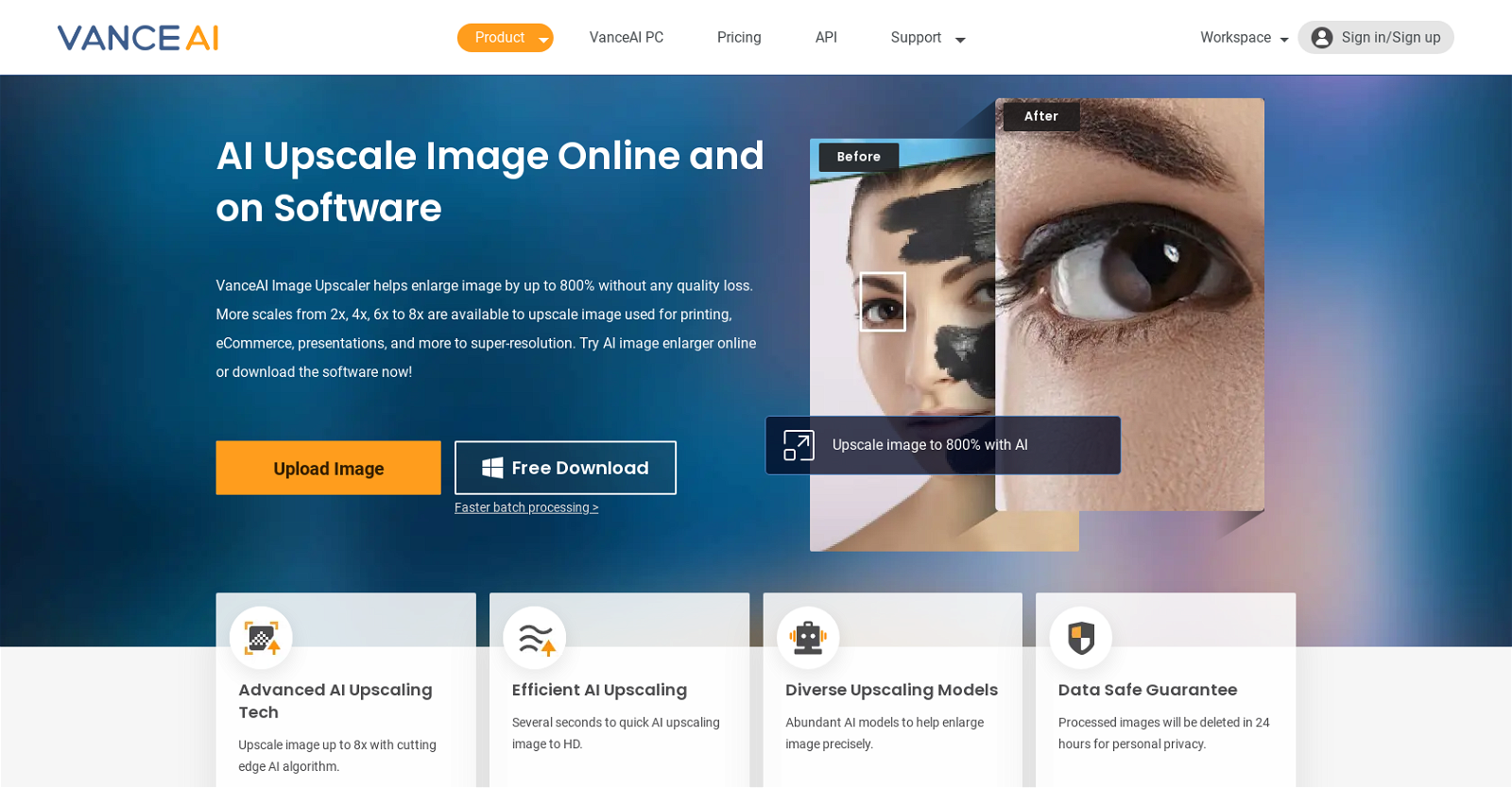
VanceAI Image Upscaler: Complete Buyer's Guide
Mid-market solution for design professionals seeking API-centric deployment and specialized processing modes
VanceAI Image Upscaler positions itself as the mid-market solution for design professionals seeking API-centric deployment and specialized processing modes without premium tool licensing costs.
Market Position & Maturity
Market Standing
VanceAI operates within the rapidly expanding AI image upscaling market, which reached approximately $1.2 billion in 2023 with growth projections indicating substantial market expansion[38][40].
Company Maturity
The vendor operates subscription-based pricing starting at $9.99/month for 100 credits, scaling to $19.99/month for 500 credits, with enterprise custom pricing available[54]. Desktop licensing provides one-time purchase options ranging from $39.90 to $199.90 based on feature requirements[53].
Growth Trajectory
The vendor's focus on API integration capabilities and batch processing functionality positions it well within market trends toward workflow integration, though competitive threats include Adobe's Firefly integration into Creative Cloud, which presents native workflow integration that VanceAI cannot match without API development[44].
Industry Recognition
VanceAI's specialized modes (particularly anime upscaling) differentiate the platform from general-purpose competitors[51][45], with the platform demonstrating notable effectiveness in anime upscaling scenarios, successfully preserving cel-shading characteristics and line art detail[45][52].
Proof of Capabilities
Customer Evidence
Design agencies report measurable efficiency gains through VanceAI implementation, with some organizations reducing asset preparation workflow time significantly[51]. E-commerce teams document improved conversion rates from upscaled product images, demonstrating tangible business value from implementation[40][43].
Market Validation
Healthcare sector adoption appears concentrated in large hospitals (500+ beds) due to computational requirements, with some implementations showing faster diagnosis turnaround times for diagnostic imaging applications[38][46].
AI Technology
VanceAI delivers multiple specialized upscaling modes targeting different design use cases: Standard mode for general images, Art mode for textured surfaces, Anime mode optimized for cel-shading preservation, and Text mode for document enhancement[51].
Architecture
VanceAI operates through both cloud API implementations and desktop application deployments. Cloud API implementations require significant developer resources for custom workflow integration, with organizations needing dedicated technical staff for optimal deployment[49]. Desktop implementations prove simpler but necessitate NVIDIA GTX 1060+ GPU configurations, potentially creating hardware upgrade requirements[51].
Primary Competitors
VanceAI competes directly with premium solutions like Topaz Gigapixel AI, open-source alternatives like Upscayl or EDSR-base, and freemium platforms like Upscale.media[51][53][41].
Competitive Advantages
VanceAI's API-centric deployment model provides advantages over desktop-only solutions for organizations requiring scalable, integrated workflows[51]. Batch processing capabilities and specialized modes (particularly anime upscaling) differentiate the platform from general-purpose competitors[51][45]. Speed advantages over premium tools like Topaz Gigapixel prove significant, with processing completing in seconds rather than minutes[47].
Market Positioning
VanceAI serves design professionals seeking middle-ground solutions between enterprise-grade tools and basic online services. The vendor targets organizations with technical resources for API implementation but seeking commercial support beyond open-source alternatives[51].
Win/Loss Scenarios
Organizations should choose VanceAI when requiring API integration capabilities, batch processing functionality, and specialized anime/illustration upscaling. Alternative solutions prove preferable when prioritizing maximum quality output (Topaz), complete customization control (open-source), or minimal financial commitment (freemium platforms)[45][47][53].
Key Features

Pros & Cons
Use Cases
Pricing
Featured In Articles
Comprehensive analysis of AI Upscaling Tools for AI Design for AI Design professionals. Expert evaluation of features, pricing, and implementation.
How We Researched This Guide
About This Guide: This comprehensive analysis is based on extensive competitive intelligence and real-world implementation data from leading AI vendors. StayModern updates this guide quarterly to reflect market developments and vendor performance changes.
55+ verified sources per analysis including official documentation, customer reviews, analyst reports, and industry publications.
- • Vendor documentation & whitepapers
- • Customer testimonials & case studies
- • Third-party analyst assessments
- • Industry benchmarking reports
Standardized assessment framework across 8 key dimensions for objective comparison.
- • Technology capabilities & architecture
- • Market position & customer evidence
- • Implementation experience & support
- • Pricing value & competitive position
Research is refreshed every 90 days to capture market changes and new vendor capabilities.
- • New product releases & features
- • Market positioning changes
- • Customer feedback integration
- • Competitive landscape shifts
Every claim is source-linked with direct citations to original materials for verification.
- • Clickable citation links
- • Original source attribution
- • Date stamps for currency
- • Quality score validation
Analysis follows systematic research protocols with consistent evaluation frameworks.
- • Standardized assessment criteria
- • Multi-source verification process
- • Consistent evaluation methodology
- • Quality assurance protocols
Buyer-focused analysis with transparent methodology and factual accuracy commitment.
- • Objective comparative analysis
- • Transparent research methodology
- • Factual accuracy commitment
- • Continuous quality improvement
Quality Commitment: If you find any inaccuracies in our analysis on this page, please contact us at research@staymodern.ai. We're committed to maintaining the highest standards of research integrity and will investigate and correct any issues promptly.